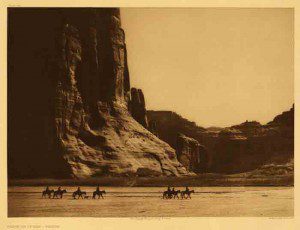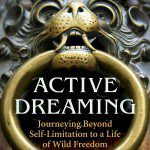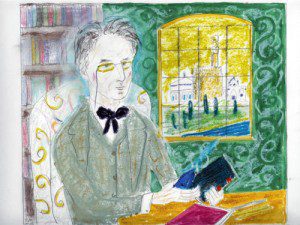 In one of my workshops in Boulder, Colorado, I was privileged to go on shared journeys into the dreamworlds with a Navajo (Dine) elder named Abraham. He told me he had driven up from Flagstaff because, “I have heard that you dream in the way of the ancestors, and can teach others how to do that.”
In one of my workshops in Boulder, Colorado, I was privileged to go on shared journeys into the dreamworlds with a Navajo (Dine) elder named Abraham. He told me he had driven up from Flagstaff because, “I have heard that you dream in the way of the ancestors, and can teach others how to do that.”
He wanted to reenter a dream from many years ago. Back in 1984, he told the smaller group of dream trackers we formed for this exploration, “I dreamed I was riding a paint across the desert with my deceased grandfather and a family friend who had also passed on.” They were riding hard towards a big rounded sandstone boulder rising above the dunes. He knew there were important teachings to be received at this place. But the dream was interrupted and he was unable to get back to that place.
When I drummed for the journey, I enjoyed galloping across the desert on a cream horse with a white mane. Rattlesnakes sounded a warning as I neared the great sandstone boulder. I could see no obvious way either to enter the sandstone — using it as a portal — or to move beyond it.
I began to feel that perhaps this was sacred territory reserved for the Navajo and that I was not welcome within it. Then I sensed something above me and looked up to find a giant eagle — an eagle as big as a mountain — hovering overhead. Its wings were striped in horizontal bands of bright rainbow colors. I looked down at the ground and saw the same rainbow eagle depicted in a sand painting at my feet.
In that moment, I realized I had stepped through the sandstone portal and been received into a Navajo imaginal world. I walked by water, and saw Abraham walking there too, with an animal ally at his heel. I heard the long blessing way chants of his grandfather, and witnessed some indigenous ways of healing.
When we shared journey reports, the deep grooves on Abraham’s face opened into a smile of delight as I described the rainbow eagle. He proceeded to tell us how he had found a place of sacred teaching and healing by water, inside the world of the sandstone boulder, and had been followed everywhere by a gila monster — regarded by his people as a great diagnostician — that he would now work with, consciously, as an ally in healing work. He pronounced “gila” the Spanish way, so it sounded like he was speaking of a “healer monster”.
Later I was privileged to have Abraham as one of my trackers when I shared a dream of my own from the night before. In my dream, I was on my way to give a lecture on Sir William Johnson (the 18th century Anglo-Irishman who became King’s Superintendent of Indians on the New York frontier, and became a key figure in my dreaming when I moved to his neighborhood in the mid-1980s). Instead of entering the auditorium, I found myself on top of a soaring mountain, inside a security fence, and had to jump down in order to give my presentation. I wanted to go back inside this dream to undertsand what was going on.
Abraham was delighted by the opportunity to play dream tracker for me. When he entered my dream space, during a new drumming session, Abraham saw the mountain becoming an eagle, with the area at the crest within the security fence as the head of a bald eagle, and then saw the mountain-sized eagle wrapping itself around me to guide and protect.
Thea, another of my trackers, had a very down-to-earth vision of my dream. She advised me to remember “not to make mountains out of molehills” and to remember to “come down to earth” in order to reach all my audiences where they live. I loved both messages, which were nicely balanced and again demonstrated how we always benefit from multiple perspectives on our dream material – especially when they come not just from the analytical mind, mulling over a report, but through a shared adventure inside the living landscapes and full experience of the dream.
 Adapted from Active Dreaming by Robert Moss. Published by New World Library.
Adapted from Active Dreaming by Robert Moss. Published by New World Library.
Navajo riders in Canyon de Chelly, Arizona. Photograph by Edward S. Curtis, 1904.

